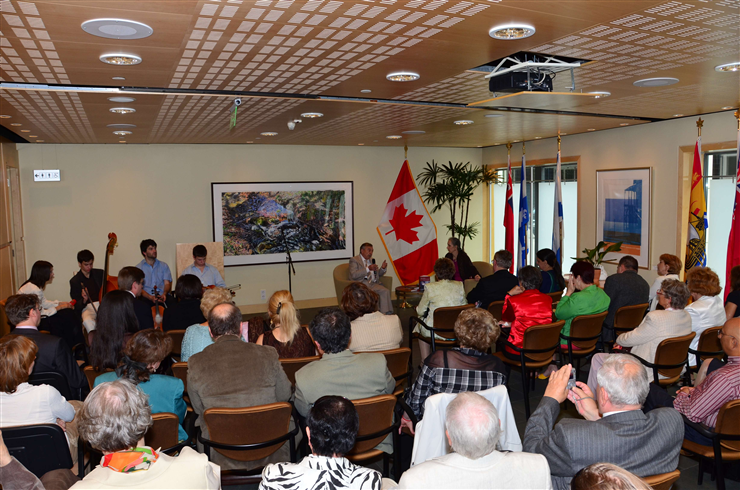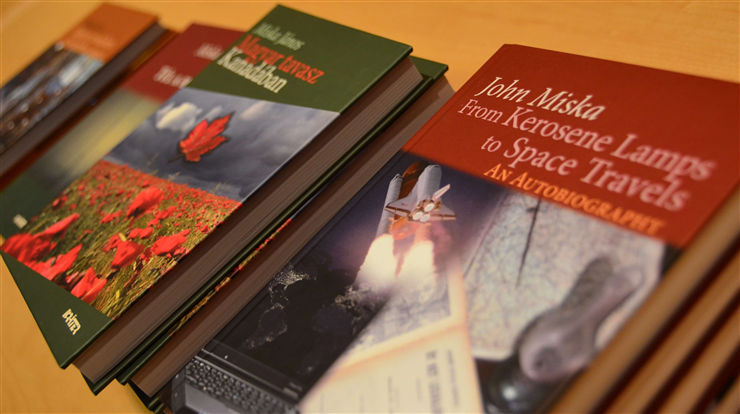October 23, 2012
Review by Mária Palla

Sampling the output of publishers in Hungary in the past twelve months, one comes across the name of John Miska more than once. Kráter Publishing House has put out four volumes by the author, forming a series which illustrates the manifold aspects of his career as a writer, translator, journalist, anthologist, librarian, bibliographer, and researcher in Hungarian Studies. The first book in the series, Túl a hídon (Across the Bridge), contains the selected short stories of the author who arrived in Canada in 1957 as a refugee following the defeat of the Hungarian Revolution of 1956 and who has been living there ever since. The second volume, Magyar tavasz Kanadában (Hungarian Spring in Canada), is a selection of Miska’s journalistic writing. The third, Magyar irodalom Kanadában: 1900-2010 (Hungarian Literature in Canada: 1900-2010), is a survey of the literary output of Hungarian-Canadian authors during the twentieth and the early twenty-first century. The final volume, From Kerosene Lamps to Space Travels: An Autobiography, was launched during a week-long festival in Budapest in June 2012, which also happened to be the largest celebration of the publication of new literature in Hungary since 1929. The following is a review of the second and third volumes in the series.
Magyar tavasz Kanadában (Hungarian Spring in Canada) contains articles written by and interviews made with John Miska between 1956 and 2010. Presented in chronological order, these pieces focus on the social and cultural life, and the various notable achievements of Hungarians who immigrated to Canada in four different waves. The first piece in the book, emblematic of the whole book, features an ordinary man who carries out his duties with great care regardless of what reward he might receive for it. Several similar portraits are included, ranging from sketches of John Miska’s gardening friends to sketches of prominent Hungarian-Canadian scientists. The reader is introduced, among others, to the entomologist László Safranyik, the one-time student of the Sopron Division of Forestry. Together with about one hundred of his former fellow-students – all refugees from Hungary following the collapse of the Revolution of 1956 – Safranyk was finally given an opportunity to graduate by the University of British Columbia in the early 1960s. Then there’s Emőke Szathmáry, who eventually became the president of the University of Manitoba. All of these people enjoy the well-deserved admiration of their fellow countrymen both in Canada and Hungary.
Reports about local events make up a significant part of the book: wherever John Miska has lived, be it Lethbridge in the prairies or Victoria on the Pacific coast, Hungarian- Canadian Cultural Centres have always played an essential part in his life. These centres have been the venues for literary evenings, golden jubilees, Father’s Days, visits by ecclesiastical leaders from Hungary, or commemorations of Hungarian national holidays. These reports of earlier times are filled with the author’s personal experiences. They give one a sense of immediacy as well as an opportunity to participate vicariously in them together with the Hungarians of Canada. To read them is to enjoy a collection of exciting moments that give meaning to life. These are snippets of immigrant life that one can treasure together with John Miska and the members of his generation.
The volume primarily consists of writings that explore how Hungarian-Canadians examine themselves. They are helpful sources that will facilitate further research in the field of Hungarian Studies. The collection contains many of John Miska’s introductions to works of literature and reveal his first-hand knowledge of these works. As a writer, editor, and anthologist, Miska can hardly be exceeded. It is interesting to follow how he comes to recognize how the understanding of Hungarian-Canadian literature has changed over time , how it has expanded to include not only works published in Hungarian but also those written in English. Language is a crucial, yet not exclusive, means of preserving one’s culture and identity, especially in a diaspora. It is really moving to read how Nancy Tóth appreciates this shift in the definition of who is a Hungarian author because it allows her to be part of a community she claimed as her own when she defined herself as a Hungarian living abroad (p. 183).

Besides literary works, John Miska regards the study of other works such as newspaper and magazine articles written in Hungarian, and documents preserved in archives and private collections as essential for the successful study of Hungarians in Canada. He does not fail to mention the achievements of Hungarian-Canadians in the sciences, such as the introduction of new principles and methods in the logging industry which have significantly improved the standards of living in their adopted land. The collection also includes an exploration of the various institutions of Hungarian-Canadians and articles about various scholarly conferences in Hungarian Studies.
The volume illustrates how Canadians view Hungarians, how encyclopaedias, novels and short stories feature characters of Hungarian origin, and how these characters are portrayed. Miska describes works translated from Hungarian into English, and major studies that have been made in Canada about Hungarian literature and that have helped Canadians to become more acquainted with this Central European culture.
To complete the list of sources that assist in researching the field, John Miska reviews some of the studies that have been made in Hungary addressing the literature of the Hungarian diaspora in Canada.
The volume closes with an interview with John Miska in 2010 in which he comments on escaping from Hungary in 1956 and the new life in Canada from several aspects. It can be read as a kind of summary of immigrant life. He explains why refugees chose Canada as their destination and describes the circumstances of their arrival, including the process of integration here. Miska comments on how those who had already started their studies in the Hungarian system of higher education could continue them in their adopted land and he also talks about the different ways immigrants coped with the difficulties that their new cultural, political, and linguistic environment created for them. He also describes the emerging politics of multiculturalism that gave the Hungarian community new opportunities to preserve their culture and identity. This concluding interview complements the articles in the volume that not only describe the life of the 1956ers, but also survey the broader history of Hungarian immigration into Canada.
While Magyar tavasz Kanadában (Hungarian Spring in Canada) ends with an interview, Magyar irodalom Kanadában: 1900-2010 (Hungarian Literature in Canada: 1900- 2010) starts with one. In this interview, the author highlights his main aims and the characteristics of his book. A central aspect of the work’s organizing principle and rationale is that Hungarian-Canadian literature has come to be more than just the works of Hungarian authors living in Canada or those of Hungarian ancestry, written in the Hungarian language. This is especially the case with the appearance of second-generation Hungarian authors. An expanded definition should also include the works of Hungarian- Canadian authors even if they write in English and select topics which do not deal with the life of the diaspora in Canada or issues related to life in Hungary. As John Miska employs the term “Hungarian-Canadian literature” in such a broad sense, he seems to endorse the relevance of a transcultural approach to the examination of the writings of authors living in their respective mother countries and their diasporas.
The book starts with a survey of Hungarian-Canadian literature written in Hungarian and follows a division by genre that begins with poetry and continues with prose fiction. Miska distinguishes three important periods in poetry. The first includes the poets of the older generation such as György Faludy, Tamás Tűz, and Ferenc Fáy, poets born in the first three decades of the twentieth century. The middle generation is comprised of such poets as György Vitéz, Ferenc Veszely or László Kemenes Géfin, all born in the 1930s. Among the members of the younger generation, the reader will find Brigitta Bali, Szabolcs Sajgó, and Ágnes Simándi, who were born during, or shortly after, the Second World War. Within each period, Miska examines the thematic and stylistic features of the major works of these authors and arranges them in chronological order. This meticulous chronological arrangement, however, does not necessarily help the author to highlight the tendencies that dominated in each period.

Miska points out that while prose fiction has had the largest audience it is poetry that has been the most popular mode of writing in Hungarian-Canadian literature until recently. It is highly commendable that the volume provides plenty of extracts to illustrate the characteristics of the works of the authors under discussion. However, those who only speak Hungarian might become puzzled with those selections from the poems of the youngest generation are printed in their English original without a Hungarian translation. It would have been better to read all the excerpts in Hungarian, too, even if only raw translations were available. However, an example of an excellent Hungarian translation is George Payerle’s poem entitled “Ancestral”.(p. 130).
John Miska’s thoughts on these poets and writers are just as exciting as his observations on the connections between the literature produced in the diaspora and the literature of the authors’ home country on the one hand, and the literature created in Canada, on the other. This duality, as he notes correctly, has become more prominent since the change of regime in Hungary. As he points out in one of the closing pieces, the future of Hungarian- Canadian literature largely depends on this dual orientation: how much support and attention it will be given in Hungary and how vital it will stay in Canada. That vitality is linked to the number of new Hungarian immigrants who are, naturally, more keen on keeping the language and literature of their ancestors alive. It is evident that the second- and third-generation Hungarians have become more integrated into the mainstream of Canadian culture than their forebears were.
Miska next talks about life-writing, a genre that has emerged only recently and introduces some of its English and Hungarian-language representatives. He then mentions some of the often neglected anthologies of the diaspora which, from the 1960s, provided immigrant authors with opportunities to publish their work. The publication of these anthologies was made possible in part through the efforts of the Hungarian- Canadian Authors’ Association, founded in 1967, as well as the generous support of key individuals. The challenges of publishing and distributing Hungarian-Canadian literature are dealt with in a separate chapter. A chapter is dedicated to the description of the most important studies, either in English or Hungarian, of this literature. Reference books are also included in this particular chapter. Indeed, throughout the book following the discussion of each individual author, one can find a list of their major works as well as relevant studies about them. Of course, it is hardly possible to make such lists complete since these studies are often published by a wide range of publishers located in many different places, often continents apart. It is not surprising, then, that some of the more recent scholarly work produced in Hungary is not documented in Miska’s book. Nevertheless, this volume is very rich in Canadian sources, including articles and studies published in Canadian periodicals – essential material for anyone showing a serious interest in the field.

The appendix contains further arguments as to why the inclusion of works written in the diaspora both in Hungarian and in English is indispensable in any comprehensive survey of Hungarian-Canadian literature. John Miska does not fail to present studies in English about Hungarian literature or to list the titles of Hungarian literature originating in Hungary that have been made available in English translation. The book also addresses the impact of the founding of institutions in Canada run by Hungarians that play an essential role in the social, cultural, literary life, and language education in the diaspora. These institutions are important venues in the life of the Hungarian-Canadian community and help ensure its survival.
To conclude, Magyar irodalom Kanadában: 1900-2010 (Hungarian Literature in Canada: 1900-2010) is a monograph extremely rich in information made user-friendly by its author who also includes an index of both names and titles. Together with Magyar tavasz Kanadában (Hungarian Spring in Canada), it provides an extensive and thorough survey of the life of the diaspora. An enjoyable read, it also manifests its author’s whole-hearted dedication to the culture and literature of Hungarian-Canadians.
